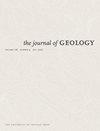东秦岭造山带台山庙A型花岗岩的岩石成因——对晚白垩世构造转换和成矿作用的启示
IF 1.3
4区 地球科学
Q2 GEOLOGY
引用次数: 0
摘要
华北克拉通南缘是东秦岭造山带最北端的构造单元,分布着大量晚中生代(晚侏罗世至早白垩世)花岗质深成岩体。该构造单元记录了华北和华南克拉通在早三叠世晚期至中三叠世大陆碰撞后发生的多次构造热事件和成矿事件。本文报道了东秦岭晚中生代最大的岩体之一台山庙花岗岩的锆石U-Pb年龄、全岩和磷灰石的地球化学组成。该花岗岩的三个相,侵位在~125和~113 Ma之间,其特征是SiO2和K2O均匀较高,但CaO、TFe2O3和MgO含量较低,Nd同位素组成富集,初始εNd值为−13.5至−12.7。地球化学特征表明,它们是以古地壳部分熔融为主的A型花岗岩。从锆石中的Ti测温和氧逸度(fO2)数据中获得的温度表明,岩浆在高结晶温度(~800°~840°C)和fO2水平(辉绿岩-磁铁矿-石英[FMQ]缓冲区-1.5至+1.5)下形成,这意味着河峪花岗岩是由增厚的地壳形成的,而东沟花岗斑岩和台山庙花岗岩很可能起源于-125-113Ma地壳变薄期间的一致岩浆系统,只是斑岩更进化。这一发现表明,它们均匀的岩浆室可以为东沟钼矿床提供充足的金属和伴生物质,甚至能量。本文章由计算机程序翻译,如有差异,请以英文原文为准。
Petrogenesis of the Taishanmiao A-type Granite in the Eastern Qinling Orogenic Belt: Implications for Late Cretaceous Tectonic Transition and Mineralization
Numerous late Mesozoic (Late Jurassic to Early Cretaceous) granitic plutons are present along the southern margin of the North China Craton (s-NCC), which belongs to the northernmost tectonic unit of the eastern Qinling orogenic belt. This tectonic unit records multiple tectonothermal and metallogenic events that occurred after continental collision of the North and South China Cratons in the late Early to Middle Triassic. This study reports the zircon U-Pb ages and the whole-rock and apatite geochemical compositions of the Taishanmiao granite, one of the largest late Mesozoic plutons in eastern Qinling. Three phases of this granite, emplaced between ∼125 and ∼113 Ma, are characterized by uniformly high SiO2 and K2O but low CaO, TFe2O3, and MgO contents and enriched Nd isotopic composition with initial εNd values of −13.5 to −12.7. Geochemical features reveal that these are A-type granites derived from partial melting mainly of ancient crust. Temperatures obtained from Ti-in-zircon thermometry and oxygen fugacity (fO2) data indicate that the magma(s) formed at high crystallization temperatures (∼800°–840°C) and fO2 levels (fayalite–magnetite–quartz [FMQ] buffer −1.5 to +1.5). Comparison with neighboring granites, such as the ∼150–130 Ma adakitic Heyu granite and the ∼115 Ma Donggou ore-bearing granite porphyry, implies that the Heyu granite formed from thickened crust and that the Donggou granite porphyry and Taishanmiao granite likely originated from a consistent magma system during the crustal thinning that occurred ∼125–113 Ma, except the porphyry rock was more evolved. This finding implies that their uniform magma chamber could provide sufficient metals and associated materials and even energy for the Donggou Mo deposit.
求助全文
通过发布文献求助,成功后即可免费获取论文全文。
去求助
来源期刊

Journal of Geology
地学-地质学
CiteScore
3.50
自引率
5.60%
发文量
0
审稿时长
3 months
期刊介绍:
One of the oldest journals in geology, The Journal of Geology has since 1893 promoted the systematic philosophical and fundamental study of geology.
The Journal publishes original research across a broad range of subfields in geology, including geophysics, geochemistry, sedimentology, geomorphology, petrology, plate tectonics, volcanology, structural geology, mineralogy, and planetary sciences. Many of its articles have wide appeal for geologists, present research of topical relevance, and offer new geological insights through the application of innovative approaches and methods.
 求助内容:
求助内容: 应助结果提醒方式:
应助结果提醒方式:


